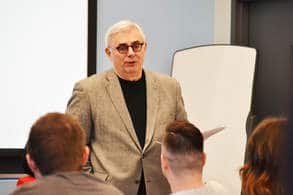It is fitting that we spent a full day at the University of Manitoba, as this institution is dedicated to both educating leaders as well as providing an environment where innovation and leadership can thrive. Throughout the day, we were given a backstage pass with access to the university’s leaders and a behind-the-scenes tour of the cutting edge research taking place at the University of Manitoba.
Our morning featured insights into leadership within the university as an organization, with Dr. Barnard explaining the university’s governance structure. He explained some of the challenges that face leaders within the university given the size of the organization, the number of stakeholders involved, and the governance processes in place.
While these processes can lead to slower decisions, they are also important to maintain values such as academic freedom. In particular, I was struck by the importance of consensus-building to leadership. At the university, this takes on the form of consultations and debate among the governing bodies, however, consensus-building can also be an important tool for effective leadership elsewhere.
We had an opportunity to see this in action by touring the Richardson Centre for Functional Foods and Nutraceuticals. Here, researchers from the university and private companies work side-by-side to formulate and commercialize products that use our prairie crops. The university provides access to capital-intensive equipment for new companies at a low cost and offers an environment where products can be taken from an idea, to production, and through clinical trials in one building.
Another way the University of Manitoba contributes to economic growth is by functioning as an idea generator to help solve industry problems. For example, the university has a partnership in place with Manitoba Hydro and university researchers are working to create models that will more accurately predict ice jams. This research will in turn help to prevent or mitigate the effects of ice jamming in the future. We were treated to a demonstration of a phenomenon known as hydraulic jump using water from a large reservoir in the Faculty of Engineering building. This water flowed through one of the large flumes used for research and gave us a clear view of the hydraulic jump that occurs when water traveling at a high velocity flows into a slower moving body of water.
While the focus of the Leadership Winnipeg program is primarily on leadership, the program also provides a unique perspective on our community and the leaders who sometimes escape the spotlight. Even though I graduated from the University of Manitoba with a 4-year degree, I left our day at the university with a new appreciation for this institution. I was impressed by the breadth and calibre of the research which is taking place at the university, and the ways in which the university is striving to educate the leaders of the future. I am prouder than ever to have the University of Manitoba as part of our community and count myself among its graduates.













